
Hãy nhập câu hỏi của bạn vào đây, nếu là tài khoản VIP, bạn sẽ được ưu tiên trả lời.


\(a,=\left(x+1\right)\left(x+3\right)\\ b,=-5x^2+15x+x-3=\left(x-3\right)\left(1-5x\right)\\ c,=2x^2+2x+5x+5=\left(2x+5\right)\left(x+1\right)\\ d,=2x^2-2x+5x-5=\left(x-1\right)\left(2x+5\right)\\ e,=x^3+x^2-4x^2-4x+x+1=\left(x+1\right)\left(x^2-4x+1\right)\\ f,=x^2+x-5x-5=\left(x+1\right)\left(x-5\right)\)

1: \(-x^2+2x+8\)
\(=-\left(x^2-2x-8\right)\)
\(=-\left(x-4\right)\left(x+2\right)\)
2: \(2x^2-3x+1=\left(x-1\right)\left(2x-1\right)\)

Câu 1:
a) 2x(3x+2) - 3x(2x+3) = 6x^2+4x - 6x^2-9x = -5x
b) \(\left(x+2\right)^3+\left(x-3\right)^2-x^2\left(x+5\right)\)
\(=x^3+6x^2+12x+8+x^2-6x+9-x^3-5x^2\)
\(=2x^2+6x+17\)
c) \(\left(3x^3-4x^2+6x\right)\div\left(3x\right)=x^2-\dfrac{4}{3}x+2\)

Cách 1: Tách một hạng tử thành tổng hai hạng tử để xuất hiện nhân tử chung.
a) x2 – 3x + 2
= x2 – x – 2x + 2 (Tách –3x = – x – 2x)
= (x2 – x) – (2x – 2)
= x(x – 1) – 2(x – 1) (Có x – 1 là nhân tử chung)
= (x – 1)(x – 2)
Hoặc: x2 – 3x + 2
= x2 – 3x – 4 + 6 (Tách 2 = – 4 + 6)
= x2 – 4 – 3x + 6
= (x2 – 22) – 3(x – 2)
= (x – 2)(x + 2) – 3.(x – 2) (Xuất hiện nhân tử chung x – 2)
= (x – 2)(x + 2 – 3) = (x – 2)(x – 1)
b) x2 + x – 6
= x2 + 3x – 2x – 6 (Tách x = 3x – 2x)
= x(x + 3) – 2(x + 3) (có x + 3 là nhân tử chung)
= (x + 3)(x – 2)
c) x2 + 5x + 6 (Tách 5x = 2x + 3x)
= x2 + 2x + 3x + 6
= x(x + 2) + 3(x + 2) (Có x + 2 là nhân tử chung)
= (x + 2)(x + 3)
Cách 2: Đưa về hằng đẳng thức (1) hoặc (2)
a) x2 – 3x + 2

(Vì có x2 và  nên ta thêm bớt
nên ta thêm bớt  để xuất hiện HĐT)
để xuất hiện HĐT)
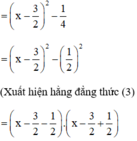
= (x – 2)(x – 1)
b) x2 + x - 6
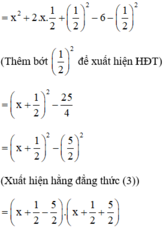
= (x – 2)(x + 3).
c) x2 + 5x + 6
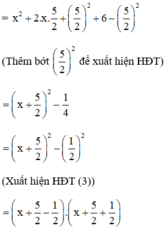
= (x + 2)(x + 3).

a) \(=x^4-14x^2+40-72=x^4-14x^2-32=\left(x-4\right)\left(x+4\right)\left(x^2+2\right)\)
b) \(=\left(x^2+5x+4\right)\left(x^2+5x+6\right)+1=\left(x^2+5x\right)^2+2\left(x^2+5x\right)+1=\left(x^2+5x+1\right)^2\)
c) \(=x^4+3x^3-3x^2+3x^3+9x^2-9x+x^2+3x-3-5=x^4+6x^3+7x^2-6x-8=\left(x-1\right)\left(x+1\right)\left(x+2\right)\left(x+4\right)\)
a: Ta có: \(\left(x^2-4\right)\left(x^2-10\right)-72\)
\(=x^4-14x^2-32\)
\(=\left(x^2-16\right)\left(x^2+2\right)\)
\(=\left(x-4\right)\left(x+4\right)\left(x^2+2\right)\)
b: Ta có: \(\left(x+1\right)\left(x+2\right)\left(x+3\right)\left(x+4\right)+1\)
\(=\left(x^2+5x+6\right)\left(x^2+5x+4\right)+1\)
\(=\left(x^2+5x\right)^2+10\left(x^2+5x\right)+24+1\)
\(=\left(x^2+5x+1\right)^2\)

a) (x - y)(x + y + 3). b) (x + y - 2xy)(2 + y + 2xy).
c) x 2 (x + l)( x 3 - x 2 + 2). d) (x – 1 - y)[ ( x - 1 ) 2 + ( x - 1 ) y + y 2 ].
phân tích các đa thức thành nhân tử
a) ( x2 + 4)2- 16x2
b) ( x+3)2- 8x3
c) (4x2-3x -18)2- ( 4x2 + 3x)2

\(a,\left(x^2+4\right)^2-16x^2=\left(x^2+4\right)-\left(4x\right)^2=\left(x^2+4-4x\right).\left(x^2+4+4x\right)=\left(x-2\right)^2.\left(x+2\right)^2\)
\(b,\left(x+3\right)^3-8x^3=\left(x+3\right)^3-\left(2x\right)^3=\left(x+3-2x\right).\left[x^2+\left(x+3\right).2x+\left(2x\right)^2\right]=\left(3-x\right).\left(x^2+2x^2+6x+4x^2\right)\)
\(c,\left(4x^2-3x-18\right)^2-\left(4x^2+3x\right)^2=\left(4x^2-3x-18-4x^2-3x\right).\left(4x^2-3x-18+4x^2+3x\right)=\left(-6x-18\right).\left(8x^2-18\right)\)

a: Ta có: \(x^2-xy-3x+3y\)
\(=x\left(x-y\right)-3\left(x-y\right)\)
\(=\left(x-y\right)\left(x-3\right)\)
b: Ta có: \(5x^2+5xy-x-y\)
\(=5x\left(x+y\right)-\left(x+y\right)\)
\(=\left(x+y\right)\left(5x-1\right)\)
c: Ta có: \(x^2-2xy+y^2-z^2\)
\(=\left(x-y\right)^2-z^2\)
\(=\left(x-y-z\right)\left(x-y+z\right)\)
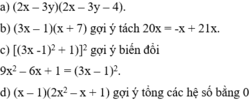
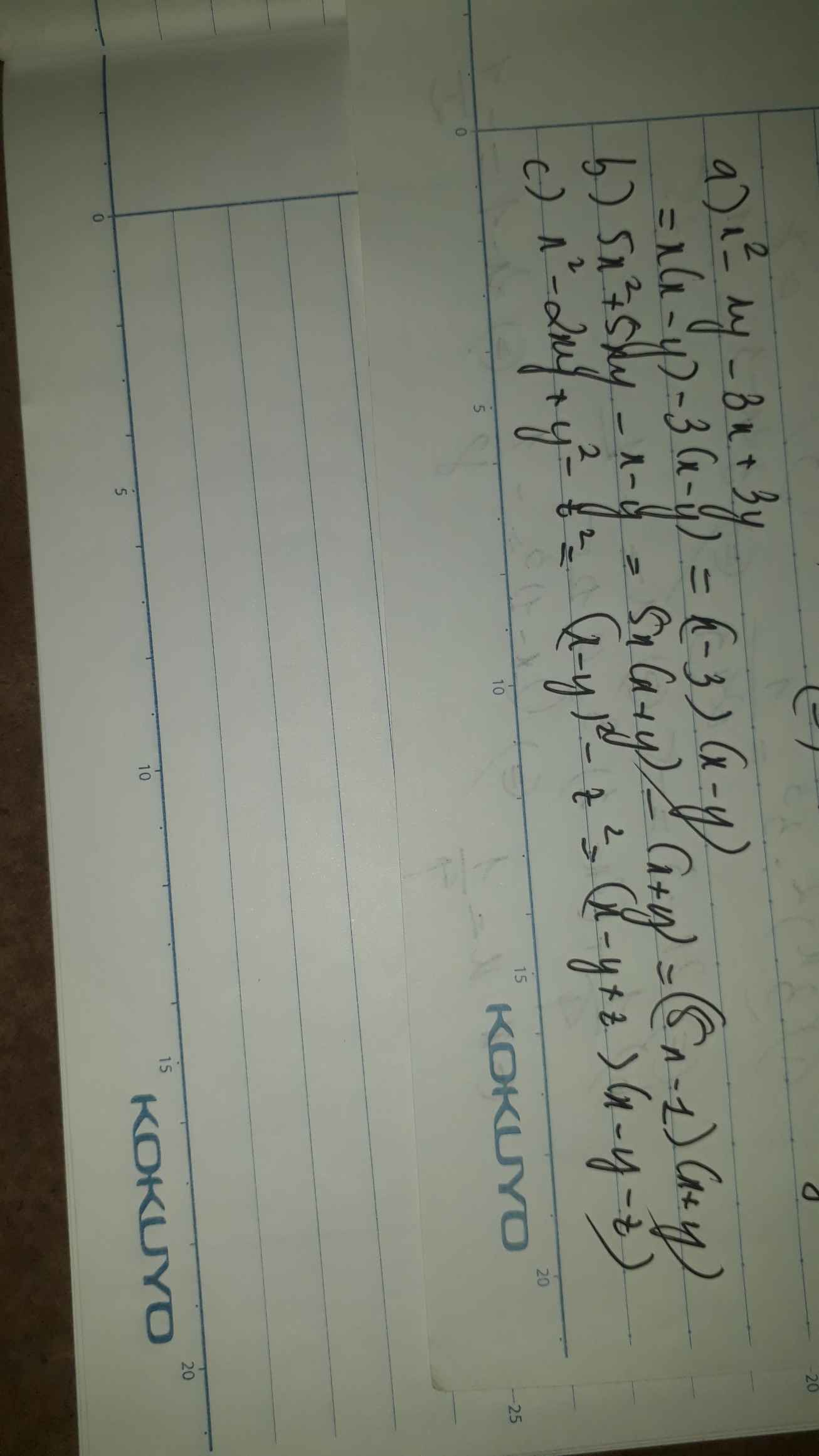
\(A=\left(x^2+3x+1\right)\left(x^2+3x-3\right)-5\)
Đặt \(t=x^2+3x+1\) thì A thành
\(t\left(t-4\right)-5=t^2-4t-5\)
\(t^2-5t+t-5=t\left(t-5\right)+\left(t-5\right)\)
\(=\left(t-5\right)\left(t+1\right)=\left(x^2+3x+1-5\right)\left(x^2+3x+1+1\right)\)
\(=\left(x^2+3x-4\right)\left(x^2+3x+2\right)\)
\(=\left(x-1\right)\left(x+1\right)\left(x+2\right)\left(x+4\right)\)
đặt a=x^2+3x+1
phương trình đã cho thành phương trình: a(a-4)-5
=a^2-4a-5
=a^2+a-5a-5
= a(a+1)-5(a+1)
=(a-5)(a+1)
=(x^2+3x-4)(x^2+3x+2)
=(x-1)(x+1)(x+2)(x+4)